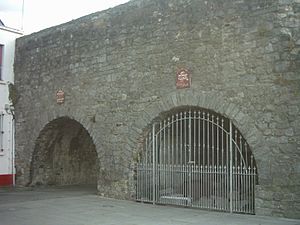Spanish Arch facts for kids
Quick facts for kids Spanish Arch |
|
|---|---|
| Native name Irish: An Póirse |
|
| Eyre Arch | |

The so-called Spanish Arch and the Caoċ Arch as they stand today, on the east bank of the Corrib
|
|
| Type | archway, part of a former city wall |
| Location | Galway, Ireland |
| Built | early 18th century |
| Lua error in Module:Location_map at line 420: attempt to index field 'wikibase' (a nil value). | |
The Spanish Arch (also known as An Póirse in Irish) and the Caoċ Arch are two old arches in Galway city, Ireland. They are the last parts of an old city wall called "Ceann an Bhalla" (which means "Front Wall"). These arches stand on the east side of the River Corrib.
Contents
A Look Back: The Story of the Arches
These two arches were once part of a bigger plan to protect Galway city. They extended the city wall from a place called Martin's Tower all the way to the River Corrib. This was done to keep the city's docks safe. These docks were in an area once known as the Fish Market, which is now called Spanish Parade.
The arches were built in 1584 when Wylliam Martin was the mayor. At that time, they were known as ceann an bhalla, meaning "the head of the wall."
How the Arches Got Their Name
In the 1700s, the Eyre family from Eyrecourt in County Galway built new docks called The Long Walk. They added the arches to let people get from the town to these new docks. When they were first built, the arches were probably called the Eyre Arch. The name "Spanish Arch" came later and is not from that time period.
A Big Wave Hits the Arches
In 1755, a huge wave, like a mini-tsunami, hit the arches. This wave was caused by a powerful earthquake that happened far away in Lisbon, Portugal. The wave damaged parts of the arches.
The Arch and the Museum
For many years, until 2006, a part of the Spanish Arch was home to the Galway City Museum. The museum then moved to a brand new building. This new building is located just behind the Arch.
The Long Walk Promenade
Right next to the arches, you'll find a lovely walking path called The Long Walk. It's a popular place for people to stroll and enjoy the views.
The Arches in Movies and More
Because the Spanish Arch is such a famous landmark, it has appeared in different movies and other media that are set in Galway. For example, you can see it in the 1957 film called The Rising of the Moon.
Images for kids
See also
 In Spanish: Arco español de Galway para niños
In Spanish: Arco español de Galway para niños



